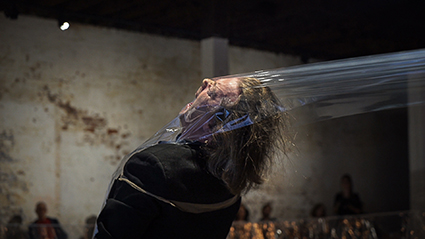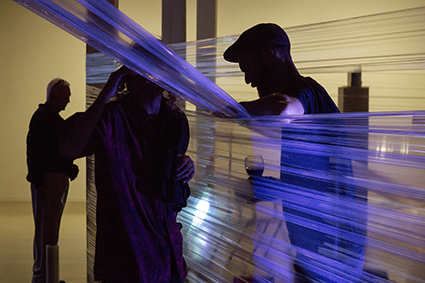 |
Johannes Sistermanns: installation, Space/Pli photo Brian Balen |
By playing on the permeability of the material, Sistermanns tries to make it disappear, to fold space around it like a wormhole in deep space. Inevitably the thickness of the material resists this intention, whether by obstructing the performers’ vision or creating acoustic barriers. For the opening of this year’s Totally Huge New Music Festival, Decibel joined Sistermanns within the stretched, scrunched and curling plastic for a baroque experiment in conceptual and musical folding.
For the duration of the performance, Sistermanns’ installation became a stage for bringing together diverse musical and performative elements. Decibel brought along their bespoke software, which coordinates scrolling graphic scores across multiple tablets. The scores were also projected on the wall of the gallery for the audience to see. The concert began with Cat Hope and Lindsay Vickery’s composition The Talking Board, which features an immense collage as a graphic score. Each performer is represented by a coloured circle that moves within the frame of the screen as it pans across the different textures and lines of the immense design. The score looks like the map of a fractured, alien landscape and the players resemble a team adventuring through dense jungles and open plains. Sometimes the circles gather around a single point and at others strike out solo across the page. Seeing the score greatly helps us appreciate the razor-sharp reflexes of the ensemble who are able to rapidly distinguish between the slightest gradations of the image.
Sistermanns began his solo performance NEW YORK sur by wrapping a length of clingfilm around a pylon and then stretching it across the space. He introduced his own body into the twisting, bending a length of plastic, squashing his face into it and singing, his voice vibrating along the length of plastic as he contorted it. He produced some beautiful shapes, including a clingfilm ‘chair’ made by stretching a length across the entire space, over his head and back and pinning the roll to the ground. He also used a larger bass transducer to make his head vibrate while vocalising.
 |
Space/Pli, 2015, photo Holly Jade |
One example of the latter may be found in the group of crochet artists whose work went viral a couple of years ago. They created a coral reef to showcase how feminine handicrafts reflect concepts in higher geometry, specifically hyperbolic space. The next best examples of hyperbolic geometry are found in the growth patterns of sea slugs and corals. Where the area of a circle increases polynomially as the radius of the circle increases (as a square of the radius), the area of hyperbolic space increases exponentially outward from a given point. This makes it difficult to represent in two dimensions, because all of that excess two-dimensional space has to go somewhere. Sea slugs and corals also grow exponentially and they fold this extra tissue into a third dimension, creating their curling, crenelated bodies. In crochet, too, if one exponentially increases the size of one’s lines, the excess material folds into a waving, crenelated surface. Hyperspace geometry can be used to conceptually fold together the worlds of crochet and marine biology. Meanwhile, crochet and marine biology demonstrate hyperspace geometry by folding conventional two-dimensional space into a third dimension.
In SPACE/PLI, 2015 Johannes Sistermanns engages with the fold in both loose and detailed ways. On the one hand, he takes it as an invitation to experiment freely with different media and musical rules, provoking chance encounters between diverse events. On the other hand, he uses Decibel’s graphic score app to fold together different timeframes within the ensemble.
Sistermanns put several measures in place to force chance combinations of sound. Decibel were spaced around the room, some inside and some outside the plastic film barrier. The screen of plastic film made eye contact difficult between the musicians, forcing them to rely on their scores. The ensemble was also invited to read the scrolling score from right, centre or left of the screen. In this way, at least three different timeframes were folded into one another. There were also moments of synchronicity where the ensemble attacked in unison. Cat Hope interpreted the thick black lines of Sistermanns’ score with thunderous growls from her bass guitar. Vickery’s bass clarinet took flight, following Sistermanns’ paint with pops and warbles. Louise Devenish was able to bring a polyphonic approach to the improvisation, painting complex multi-voiced textures with her extended percussion battery. Aaron Wyatt kept things fairly quiet, following the score with gliding pitches on the violin. Tristen Parr drew a dazzling array of sounds from his cello with an enormous rack of effects pedals.
On Monday at 11am, Johannes Sistermanns dismantled his installation by driving a car through it.
Space/Pli 2015,Johannes S. Sistermanns and Decibel Ensemble; Cat Hope and Lindsay Vickery, The Talking Board; Johannes S. Sistermanns, NEW YORK sur_ [Fold 2/ Version Fremantle 2015], SPACE/PLI, 2015, for Decibel. Totally Huge New Music Festival, PS Art Space, Fremantle, 15 May
© Matthew Lorenzon; for permission to reproduce apply to [email protected]








 back
back